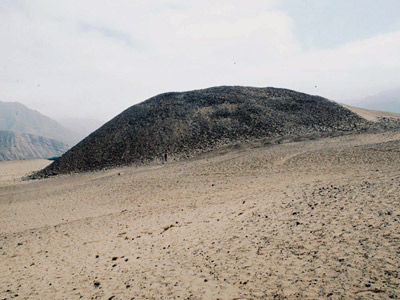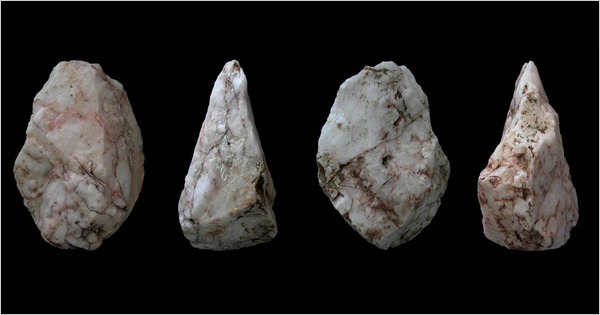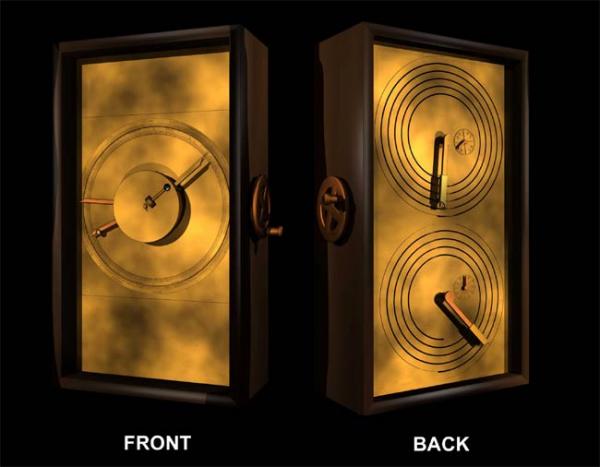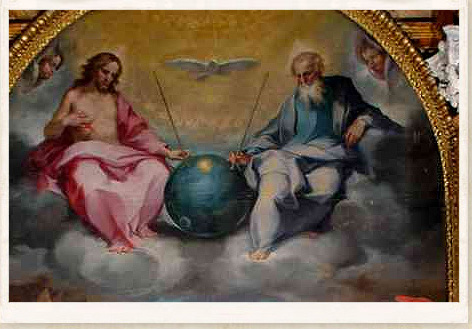It looks like you're using an Ad Blocker.
Please white-list or disable AboveTopSecret.com in your ad-blocking tool.
Thank you.
Some features of ATS will be disabled while you continue to use an ad-blocker.
share:
So there are always discussions of science, and explorers making finds that cannot be explained. Supposedly we were something like this.

Very rarely do you see someone trying to say what it is, except that "they" cannot figure it out and it remains a mystery. Even more rare than that is us trying to maybe, just maybe come to a different conclusion, one where maybe we were smarter that the average bear.
Hey I am no ancient civilization teacher (yeah thats what I call it LOL), but I thought I would go back pretty far and see what we actually have found, and see if we can come up with some conclusions on our own.
I would like to add a few things that I would consider common sense when describing the past, and how the way to look forward and answer questions that may be confusing us as a species can be answered... when asking the right questions.
Did climate change create a mysterious civilization 5,000 years ago?

science.howstuffworks.com...
On Crete, New Evidence of Very Ancient Mariners

www.nytimes.com...
Ancient Human Metropolis Found in Africa

www.viewzone.com...
OK this is a bit more recent but beautiful.

www.livescience.com...
I wanted to close with this one. I have never seen it before, but wondered what was being conveyed here?
I thought this was interesting.
GLORIFICATION OF THE EUCHARIST

www.aquiziam.com...
More will be added, share your thoughts and ideas.
Peace, NRE.

Very rarely do you see someone trying to say what it is, except that "they" cannot figure it out and it remains a mystery. Even more rare than that is us trying to maybe, just maybe come to a different conclusion, one where maybe we were smarter that the average bear.
Hey I am no ancient civilization teacher (yeah thats what I call it LOL), but I thought I would go back pretty far and see what we actually have found, and see if we can come up with some conclusions on our own.
I would like to add a few things that I would consider common sense when describing the past, and how the way to look forward and answer questions that may be confusing us as a species can be answered... when asking the right questions.
Did climate change create a mysterious civilization 5,000 years ago?
In 2001, archaeologists digging in Peru revealed a shocking discovery: massive man-made structures, hundreds of feet in diameter, built with stone and dirt. They found dozens of these mounds in the arid valleys of Peru's Norte Chico region, running from the Andes Mountains to the west coast.
They look like flat-topped pyramids, up to 85 feet (26 meters) tall [source: ScienceDaily]. Compared to the pyramids of the Mayan empire in South America or, later, the Incan empire in Peru -- structures that were hundreds of feet tall -- that's not so impressive. Except that these mounds in Norte Chico predate any large structures attributed to either the Incas or the Mayans. (They're even older than the Egyptian pyramids, for that matter.) It seems that these Peruvian mound builders were the first complex civilization in the Americas.

science.howstuffworks.com...
On Crete, New Evidence of Very Ancient Mariners

Early humans, possibly even prehuman ancestors, appear to have been going to sea much longer than anyone had ever suspected.
Crete has been an island for more than five million years, meaning that the toolmakers must have arrived by boat. So this seems to push the history of Mediterranean voyaging back more than 100,000 years, specialists in Stone Age archaeology say. Previous artifact discoveries had shown people reaching Cyprus, a few other Greek islands and possibly Sardinia no earlier than 10,000 to 12,000 years ago.
The oldest established early marine travel anywhere was the sea-crossing migration of anatomically modern Homo sapiens to Australia, beginning about 60,000 years ago. There is also a suggestive trickle of evidence, notably the skeletons and artifacts on the Indonesian island of Flores, of more ancient hominids making their way by water to new habitats.
www.nytimes.com...
Ancient Human Metropolis Found in Africa

They have always been there. People noticed them before. But no one could remember who made them -- or why? Until just recently, no one even knew how many there were. Now they are everywhere -- thousands -- no, hundreds of thousands of them! And the story they tell is the most important story of humanity. But it's one we might not be prepared to hear.
Something amazing has been discovered in an area of South Africa, about 150 miles inland, west of the port of Maputo. It is the remains of a huge metropolis that measures, in conservative estimates, about 1500 square miles. It's part of an even larger community that is about 10,000 square miles and appears to have been constructed -- are you ready -- from 160,000 to 200,000 BCE!
Once the ruins were examined, the researchers were anxious to place the lost civilization in a historical perspective. The rocks were covered with a patina that looked very old but there were no items sufficient for carbon-14 dating. It was then that a chance discovery revealed the age of the site, and sent a chill down the spine of archaeologists and historians!
www.viewzone.com...
OK this is a bit more recent but beautiful.

Scientists have finally demystified the incredible workings of a 2,000-year-old astronomical calculator built by ancient Greeks.
A new analysis of the Antikythera Mechanism [image], a clock-like machine consisting of more than 30 precise, hand-cut bronze gears, show it to be more advanced than previously thought—so much so that nothing comparable was built for another thousand years.
"This device is just extraordinary, the only thing of its kind," said study leader Mike Edmunds of Cardiff University in the UK. "The design is beautiful, the astronomy is exactly right…In terms of historical and scarcity value, I have to regard this mechanism as being more valuable than the Mona Lisa."
www.livescience.com...
I wanted to close with this one. I have never seen it before, but wondered what was being conveyed here?
I thought this was interesting.
GLORIFICATION OF THE EUCHARIST

Located in the recently restored church of San Pietro, Montalcino, Italy, are three beautiful works of art. The one located immediately behind the alter is called the Glorification of the Eucharist and was painted just before 1600 AD by the very talented artist Ventura Salimbeni. What makes this painting both rare and unusual is the focal point which features a mechanical device that strongly resembles a satellite or observation drone. Although this has been refuted as nothing more than a creation globe there are a few points worth noting that challenge this rather high-handed dismissal.
The device clearly has telescopic antenna, what appears to be a camera (or lens) as well as a spotlight. According to some people the lens is a depiction of the moon and the light is a depiction of the sun. If this is the case then the moon is a double crescent and the Sun is depicted proportionally smaller than it should be. In addition, the antennas are clearly fixed to the globe with grommet-like devices and are tipped with aerial spheres. The globe also displays lines which have been claimed to represent early longitude lines on the globe of the Earth. (We should have better image soon.) In fact, the lines look like the joins in metal plates and perhaps that is what they are.
www.aquiziam.com...
More will be added, share your thoughts and ideas.
Peace, NRE.
reply to post by NoRegretsEver
In the last bit It's just two stoners pointing out the vents on the Deathstar
In the last bit It's just two stoners pointing out the vents on the Deathstar
edit on 10-6-2013 by EA006 because: (no reason given)
There are several videos on YouTube about the Antikythera mechanism.
Here are just a few of them:
Antikythera mechanism working model
Ancient Discoveries - The Antikythera Machine
The Antikythera Mechanism - 2D
Virtual Reconstruction of the Antikythera Mechanism
Here are just a few of them:
Antikythera mechanism working model
Ancient Discoveries - The Antikythera Machine
The Antikythera Mechanism - 2D
Virtual Reconstruction of the Antikythera Mechanism
reply to post by NoRegretsEver
It seems Op the who sit outside of the sphere are designing with paint brushes fit to match their height... The entities in the background Watching Over however are intriguing as they observe... the painters of EA*RTH
NAMASTE*******
It seems Op the who sit outside of the sphere are designing with paint brushes fit to match their height... The entities in the background Watching Over however are intriguing as they observe... the painters of EA*RTH
NAMASTE*******
reply to post by NoRegretsEver
Interesting thread NoRegretsEver
Some comments
Lots of stuff is older than the pyramids
The mounds in Peru are impressive but the work involved in them pales against the amount of work done by the Egyptians and Sumerians to build their irrigation systems
Yep Neanderthals may have made it to islands in the Mediterranean, the famous Malta tooth may be evidence of that
Ah, no Michael Tellinger the guy who made this one up is Sitchinite, he basically looked at kraals and decided that they were an 'ancient civilization'....not supported
As you noted yourself the Antikythera mechanism is well beyond the period of time in question, great piece of engineering for its time but showing that the makers were not that advanced - its set up for a geocentric model
San Pietro, Montalcino, Italy its a bird ( Holy Spirit in the shape of a dove) just look at a picture with better resolution------
Here is a link debunking the most common 'mysterious things in Medieval art'
Link
Interesting thread NoRegretsEver
Some comments
Lots of stuff is older than the pyramids
The mounds in Peru are impressive but the work involved in them pales against the amount of work done by the Egyptians and Sumerians to build their irrigation systems
Yep Neanderthals may have made it to islands in the Mediterranean, the famous Malta tooth may be evidence of that
Ah, no Michael Tellinger the guy who made this one up is Sitchinite, he basically looked at kraals and decided that they were an 'ancient civilization'....not supported
As you noted yourself the Antikythera mechanism is well beyond the period of time in question, great piece of engineering for its time but showing that the makers were not that advanced - its set up for a geocentric model
San Pietro, Montalcino, Italy its a bird ( Holy Spirit in the shape of a dove) just look at a picture with better resolution------
Here is a link debunking the most common 'mysterious things in Medieval art'
Link
Nice !
Did you realize the Greek machine was perfectly build to work. Every part of it. That means a long and even large group of specialized skills for each component that existed long enough to create perfect products.
Our idea of advanced ancient culture needs an upgrade.
www.bbc.co.uk...
The link leads to human migrations from Africa.
Did you know modern man had sex and interbreed with about any other human like neighbor since the beginning ? Modern human isn't even existing. No unique originally modern man has survived.
Only African people don't share genes of some of the other human species... Like Neanderthal.
I like to read about us not being superior and most fit to survive idea. The interbreeding even was genetically the best thing that could happen as the different disease and local immunity of these otherwise deadly encounters caused genetic variable people that made us a stronger species.
I'm of topic though. I posted it cause that's the last published data. It could fit yours. I forgot to remember what exactly was the primary goal but if the people did have left in time to get at the location in your topic it's another plausible bit of info.
Did you realize the Greek machine was perfectly build to work. Every part of it. That means a long and even large group of specialized skills for each component that existed long enough to create perfect products.
Our idea of advanced ancient culture needs an upgrade.
www.bbc.co.uk...
The link leads to human migrations from Africa.
Did you know modern man had sex and interbreed with about any other human like neighbor since the beginning ? Modern human isn't even existing. No unique originally modern man has survived.
Only African people don't share genes of some of the other human species... Like Neanderthal.
I like to read about us not being superior and most fit to survive idea. The interbreeding even was genetically the best thing that could happen as the different disease and local immunity of these otherwise deadly encounters caused genetic variable people that made us a stronger species.
I'm of topic though. I posted it cause that's the last published data. It could fit yours. I forgot to remember what exactly was the primary goal but if the people did have left in time to get at the location in your topic it's another plausible bit of info.
reply to post by Sinter Klaas
"Our idea of advanced ancient culture needs an upgrade. "
I agree. We would rather think of things that have been found that are "unidentifiable" as mysterious, as opposed to realizing the intelligence that has been and resided all over the world.
I am going to write a thread here in a bit, about how we treated those in the not so distant past, and how barbaric we have become, since the time that people think we ran around clubbing people and dragging our knuckles.
Peace, NRE.
"Our idea of advanced ancient culture needs an upgrade. "
I agree. We would rather think of things that have been found that are "unidentifiable" as mysterious, as opposed to realizing the intelligence that has been and resided all over the world.
I am going to write a thread here in a bit, about how we treated those in the not so distant past, and how barbaric we have become, since the time that people think we ran around clubbing people and dragging our knuckles.
Peace, NRE.
reply to post by NoRegretsEver
Stephen Quayle has 8-9 books on this topic. Some of them are kooky, but he is a dedicated researcher. You might find a lot just going through the footnotes.
Stephen Quayle has 8-9 books on this topic. Some of them are kooky, but he is a dedicated researcher. You might find a lot just going through the footnotes.
reply to post by Hanslune
Of course its a bird. Everyone is talking about the metal globe beneath the bird.
Of course its a bird. Everyone is talking about the metal globe beneath the bird.
reply to post by SammyB0476
Maybe you should take a peak at the link provided.
Just one of several similar representations:
Maybe you should take a peak at the link provided.
Just one of several similar representations:
Originally posted by SammyB0476
reply to post by Hanslune
Of course its a bird. Everyone is talking about the metal globe beneath the bird.
Oh sorry wrong fringe claim, so you're impressed by a globe? I see you didn't look at the link if you had..
Finally there is the controvert discussion about the so called UFO or “Sputnik” of Montalcino. This is actually the name so often used by certain sites to refer to the object represented in the church of St. Peter in Montalcino. The pages of Edicolaweb for example reads: “it recalls indeed the Russian artificial satellites”. It is worth to mention that hypothesis of this kind lost strength after the publishing of the article by Samuele Ghilardi, Amos Migliavacca and Elenio Salmistraro: “The Satellite of Montalcino”.
The authors describe how the painting has been analyzed by means of photographs taken from short distance and declare to agree with Ion Hobana, who states:
«It's very interesting the interpretation of Ion Hobana, great expert of UFOs and author of the optimal volume " Enigme pe cerul istoriei ". He said the object would be an ancient map of the world, representative the Creation Globe, in which the sun is visible and a primitive shape of marking of the meridians and parallels; moreover the small cylinder would be the hinge for being able to fix to a support the sphere. An example is visible in Vatican. From the analyses carried out on the photographies and the painting originates them cannot be gained elements that make to suppose a ufologico event, while they have been finds numerous points to you in common with Greek-orthodox religious raffigurazioni. In many icons coming from from the East it is possible to notice spheres with the same symbols and tracings, accompanied or from the single figure of the Christ or from all the Trinity.»
Even this painting proves to be at least not so different from any other of the same gender. Indeed all paintings in which the Trinity is represented show Jesus, the Father and the Holy Spirit in the shape of a dove. Usually even the “Creation Globe” is presented, symbolizing not simply the Earth but the universe as a whole. In addition many paintings present also the “wands” hold by Jesus and the Father, which are frequently described as the antennas of the sputnik. The first two are "The Adoration of the Holy Trinity" (1640) by Johann Heinrich Schonfeld and " La Messe de Fondation de l'order des Trinitaires" (1666) by Juan Carreno De Miranda. Both the paintings are displayed at the Louvre Museum, Paris.
It always helps to read the links provided on that same link you can see other 'globes' - additionally look at phages image for 'antennas'.
edit on 12/6/13 by Hanslune because: (no reason given)
As far as Im concerned art is explained by the person who see it, not the painter.
I have seen "art" with 2 streaks from a brush and people see an entire story. Art is something that I have never been able to understand, but its fascinting, and open to all and any interpretations.
Peace, NRE.
I have seen "art" with 2 streaks from a brush and people see an entire story. Art is something that I have never been able to understand, but its fascinting, and open to all and any interpretations.
Peace, NRE.
GLORIFICATION OF THE EUCHARIST
This looks very much like Jesus & God painting a picture of life on earth with 2 paint brushes, and the 2 lights are the Sun (Yellow) and Moon (White)
This looks very much like Jesus & God painting a picture of life on earth with 2 paint brushes, and the 2 lights are the Sun (Yellow) and Moon (White)
Originally posted by NoRegretsEver
As far as Im concerned art is explained by the person who see it, not the painter.
I have seen "art" with 2 streaks from a brush and people see an entire story. Art is something that I have never been able to understand, but its fascinting, and open to all and any interpretations.
Peace, NRE.
But your claim from the first post would mean that a artist saw and painted circa 1600 a satellite in between some dudes? It would help the person who sees the art to know the history of icongraphy of Catholic imagery of that time.
The one part of the painting you seem to find interesting (why not the rest of the painting?) shows a symbolized heaven, dominated by the three beings of the trinity who are looking down on earth, the beings shown are God, JC and the holy spirit. Below him(not shown in your cropped image) are the Pope and other functionaries of the church, etc
So in your estimation why would Salimbeni paint a satellite and place it amongst a classic Catholic representation of their religion?
edit on
12/6/13 by Hanslune because: (no reason given)
reply to post by Hanslune
I wanted to close with this one. I have never seen it before, but wondered what was being conveyed here?
I thought this was interesting.
That was ALL I wrote concerning that painting. There is nothing wrong with other members seeing different interpretations of the same painting, and I was pointing that out.
I wanted to close with this one. I have never seen it before, but wondered what was being conveyed here?
I thought this was interesting.
That was ALL I wrote concerning that painting. There is nothing wrong with other members seeing different interpretations of the same painting, and I was pointing that out.
Originally posted by NoRegretsEver
reply to post by Hanslune
I wanted to close with this one. I have never seen it before, but wondered what was being conveyed here?
I thought this was interesting.
That was ALL I wrote concerning that painting. There is nothing wrong with other members seeing different interpretations of the same painting, and I was pointing that out.
You posted from a website the following on that painting
The device clearly has telescopic antenna, what appears to be a camera (or lens) as well as a spotlight. According to some people the lens is a depiction of the moon and the light is a depiction of the sun. If this is the case then the moon is a double crescent and the Sun is depicted proportionally smaller than it should be. In addition, the antennas are clearly fixed to the globe with grommet-like devices and are tipped with aerial spheres. The globe also displays lines which have been claimed to represent early longitude lines on the globe of the Earth. (We should have better image soon.) In fact, the lines look like the joins in metal plates and perhaps that is what they are.
You put up one point of view and no other, no counter statement that are easily findable, that would tend one to believe you flavoured that particular speculation in isolation from any other explanation.
reply to post by Hanslune
I am not sure about threads you have written, but when you use something from a website, most such as I tend to link a bit from the site, and the link itself.
I cannot and will not change the site links information. I posted it for others to share their opinion, without automatically claiming that others opinions were wrong, or right. I shared something that I thought was interesting, and others are sharing their thoughts.
The thread was not solely about the photo, but about other things that I cited.
Peace, NRE.
I am not sure about threads you have written, but when you use something from a website, most such as I tend to link a bit from the site, and the link itself.
I cannot and will not change the site links information. I posted it for others to share their opinion, without automatically claiming that others opinions were wrong, or right. I shared something that I thought was interesting, and others are sharing their thoughts.
The thread was not solely about the photo, but about other things that I cited.
Peace, NRE.
reply to post by Phage
I'm more interested in why did so many painters draw babies heads in their pictures? To me, they all look like Hannibal Lectors students
I'm more interested in why did so many painters draw babies heads in their pictures? To me, they all look like Hannibal Lectors students
I find it also interesting that in both pics (the one from the OP and the one added by Phage)...that the two figures are shown wearing either pink or
blue...which (to me) represents 'male' and 'female'. (Not the figures themself obviously, but perhaps what they are 'creating'??)
jacygirl
jacygirl
new topics
-
Swedish Minister for Gender Equality is Seeking Treatment for Phobia of Bananas
Other Current Events: 7 hours ago -
Satanic ‘Little Season’ of Deception.. Awaken to the Handiwork of the Creator.
ATS Skunk Works: 8 hours ago -
USA-BIDEN and CHINA-Xi Agree Not To Let Artificial Intelligence Decide Nuclear Weapons Use.
World War Three: 8 hours ago -
The mysterious death of Aileen Conway
General Chit Chat: 11 hours ago
top topics
-
The mysterious death of Aileen Conway
General Chit Chat: 11 hours ago, 6 flags -
Swedish Minister for Gender Equality is Seeking Treatment for Phobia of Bananas
Other Current Events: 7 hours ago, 4 flags -
USA-BIDEN and CHINA-Xi Agree Not To Let Artificial Intelligence Decide Nuclear Weapons Use.
World War Three: 8 hours ago, 3 flags -
Satanic ‘Little Season’ of Deception.. Awaken to the Handiwork of the Creator.
ATS Skunk Works: 8 hours ago, 3 flags -
Half-Life 2 is 20 Years Old - its Also Free on Steam until the 18th
Video Games: 15 hours ago, 1 flags
active topics
-
Russia Ukraine Update Thread - part 3
World War Three • 6815 • : Freeborn -
Satanic ‘Little Season’ of Deception.. Awaken to the Handiwork of the Creator.
ATS Skunk Works • 5 • : Athetos -
Swedish Minister for Gender Equality is Seeking Treatment for Phobia of Bananas
Other Current Events • 3 • : Athetos -
Bucks County commissioners vote to count illegal ballots in Pennsylvania recount
2024 Elections • 22 • : Enduro -
The JAN 6th 2021 U.S. Capitol Unrest Charges Against Former President TRUMP Were Dropped Today.
US Political Madness • 13 • : WeMustCare -
I’m Looking for Information on the Light We See at Death.
The Gray Area • 63 • : whereislogic -
President-elect TRUMP Picks MATT GAETZ for his ATTORNEY GENERAL - High Level PANIC Ensues.
2024 Elections • 93 • : EyeoftheHurricane -
On Nov. 5th 2024 - AMERICANS Prevented the Complete Destruction of America from Within.
2024 Elections • 157 • : WeMustCare -
Candidate TRUMP at MADISON SQUARE GARDEN - Sold Out in Just 3 Hours - Sun Oct 27th 2024.
2024 Elections • 51 • : WeMustCare -
Does the Trump win mean No More Taylor Swift??
Politicians & People • 50 • : bluesman023
